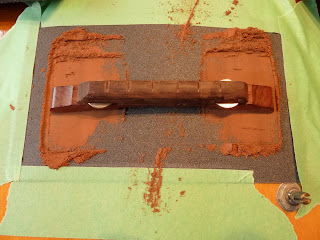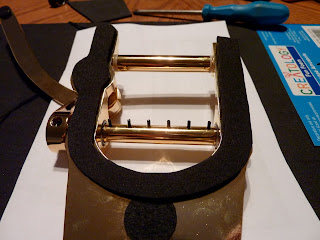It's amazing what people have tucked away in their closets! These guitars also carried the name Supro and Tosca with different configurations and colour schemes for each. Valco was a very popular manufacturer at the time, and this was their answer to the new solid body craze started by Fender and Gibson. This one is in for a set-up and general cleaning to be put back in service again...
This nifty little short-scale guitar was made with quality components and it's unique characteristics make it a sought after model for slide players ~ just like the owner, who traded a record for this little gem many years ago! It didn't play well at the time, so became a closet dust collector for future consideration...
To my surprise this is an unfixed bridge, with the tailpiece held on only by the strap pin, meaning string alignment, action and intonation adjustments will be a bit more challenging than usual.
Removal of the tailpiece revealed the grounding wire, which was also fastened down by the solid brass strap pin.
These models were available with one or two pickups, but all bodies were apparently routed for two. An interesting top-mounted pickup with channels below to hide the wire under the pickguard. The neck joint is also rather unconventional, in that the neck profile carries through the entire length and the body mount was relief-cut to match the curve, then bolted on with two screws.
A vintage paper-in-oil .05uf capacitor is wired between the tone control and the sliding two-position switch, conceivably to cut some of the high end at will. This component is long past it's expiry date and has little effect now, but will be left in at the owner's request to keep it all original.
Not a very tidy soldering job, but decent quality components that have stood the test of time.
This strange pickup looked even stranger when opened up!
Two coils mounted side-by-side. This is relatively high output, measuring 9.2. After this guitar was cleaned, polished and re-assembled with complete set-up, this pickup produced a surprisingly rich and balanced clean tone.
With it's short scale, this guitar looks more like a child's guitar. It was tuned to open E then one full step up so the strings were (low-high) F, C, F, A, C, F to give a little more tension while also producing some inspiring tone! Through a low-watt tube amp and a glass slide, this diminutive little National became quite a monster!

















































